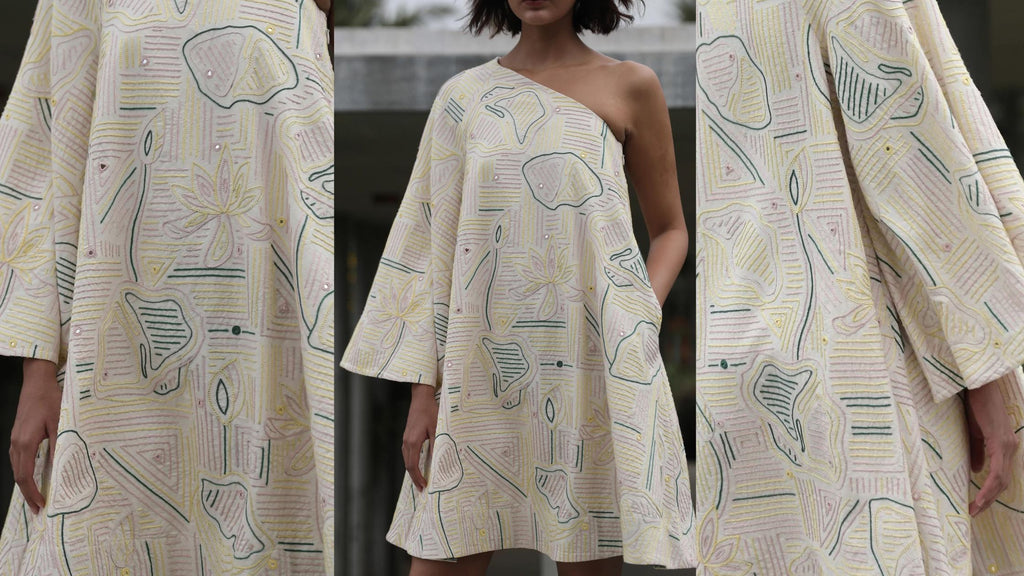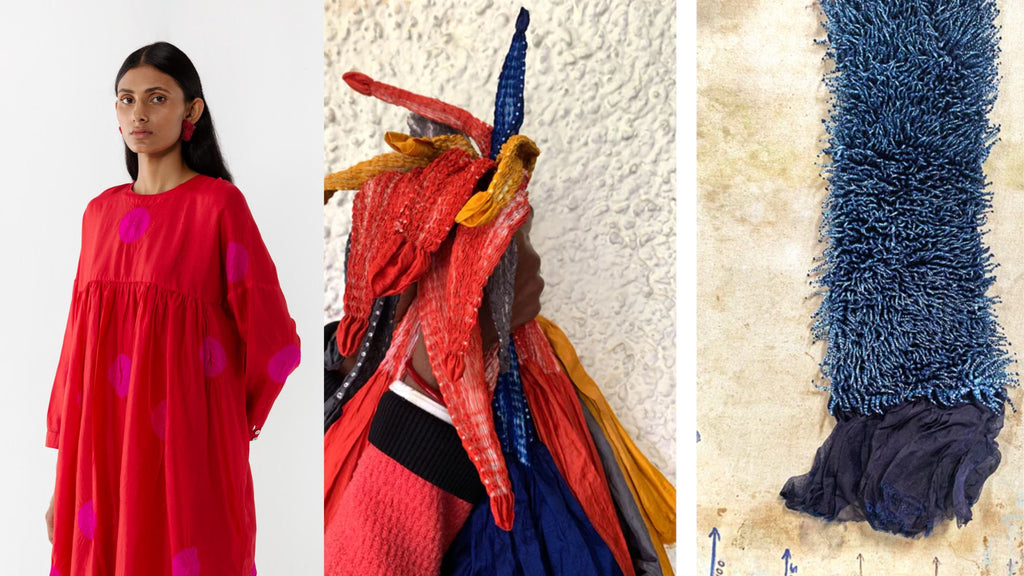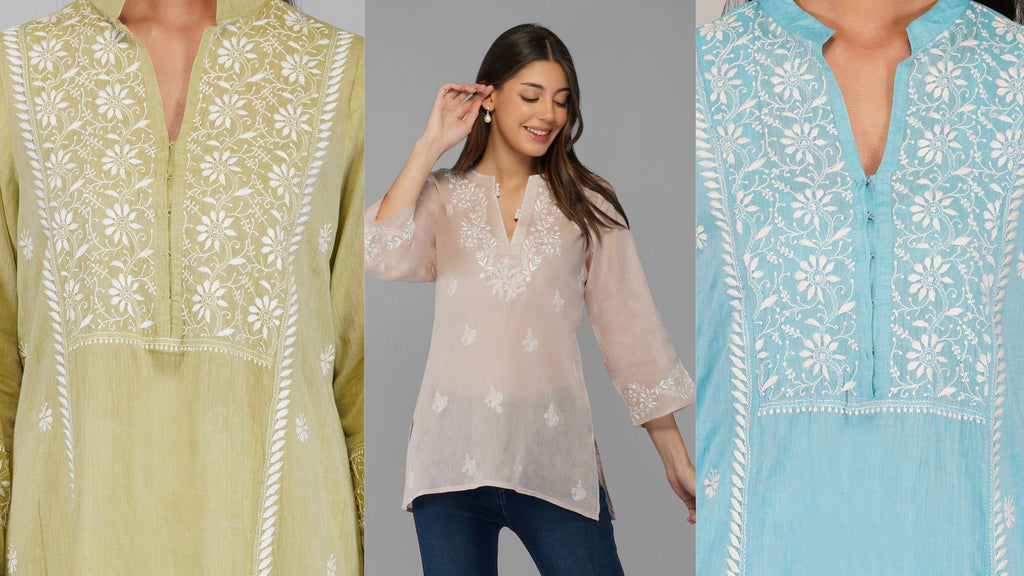IKAT
Bandhani AKA Tie-Dying
The Made in India Bandhani treasures by Pot Plant and MEDIUM offer fresh iterations of the tie-and-dye craft to add to your wardrobe, with strategically placed motifs on dresses, shirts, bottoms and so much more! Traditional to the artisanal cultures of Rajasthan and Gujarat, Bandhani is one of India’s most popular and recognizable crafts.
The resist technique of tie-and-dye derives its name from the Sanskrit word bandhana, literally tying together. Pinch-size portions of fabrics are tied together using a special thread used only for Bandhanis. After an entire piece of fabric is tied together in various pinches, it is dyed colorfully. These pinches are then opened, leaving white or gray blocks wherever the fabric was pinched and tied together. After the making of Bandhani is over, it results in a variety of symbols including dots, waves, strips, and squares. Depending on the manner in which the cloth is tied, Bandhej patterns include Lehriya, Mothra, Ekdali, etc. Bandhani is offered in different varieties; Ekdali means a single knot, Trikunti means three knots; Chaubandi means four knots, and Boond means a small dot with a dark center.
Fun Fact: In Gujarati culture, every girl buys a Bandhani when she gets married. Most of the time, a Bandhani saree is passed down through generations. A mother would give it to her daughter, and the daughter will further pass it onto her daughter.
Hand Block-Printing

Born out of a passion for craft, culture, and print, both Jodi and Tokree offer a centuries-old technique of hand block-printing in their designs.
Hand block printing is a centuries-old Indian art form that utilizes a hand-carved teak wood block that is dipped in dye and stamped by hand onto 100% natural cotton or silk textiles. The traditional process of hand block printing on textiles, with rich natural colors, has been practiced in Rajasthan for around 500 years. Block printing was introduced to the Jaipur region of Rajasthan by the Chhipa community. The art of block printing has been passed down for generations within families and communities and has branched out in recent decades to other regions.
Love for Indigo Dyeing

The lustrous blue tones of natural indigo dye are a favorite of many around the world, right? The sheen that this color brings almost adds aesthetic beauty to anything that it is used for.
The leaves of the indigofera tinctoria plant are gathered in huge bundles, before being soaked and fermented in water and lye. The leaves are then removed, leaving indigo white in the water, which is oxidized and turns an intense shade of blue. This watery substance is whisked, and a blue color settles, forming a watery clay that is heated or sun-dried into dye cakes. Fabrics dyed with these intense color cakes have a vibrant, steadfast color and richness of texture that is unrivaled.
Traditional indigo dyeing is a regenerative craft - it not only avoids a harmful impact on the surrounding environment, but it creates a positive one. The wastewater from natural indigo dyeing can be used as irrigation for crops, and the nitrogen-rich plant waste is a natural fertilizer. A perfect example of promoting sustainable farm-to-textile systems across India, Khara Kapas extensively uses natural Indigo dyeing techniques in their timeless dresses.
Indigo dye structure has a unique property that makes the fabric last for ages! By attaching its molecules to each string of the fabric, it wraps around it like skin, making the fabric extremely durable.
Natural Indigo Dye - Fun Facts
In addition to enhancing the color's tone, indigo also offers several skin benefits, including:
• Having a sedative and calming effect on the skin • Being used by some Indian tribes to control bleeding • Being useful for curing coughs, dermatitis, and chest pain • Acting as a pest control according to Japanese belief
Screen Printing
Yam creates print-centric collections that are bold, vibrant, and joyous, bringing liveliness and mood-boosting energy to your wardrobe. Screen printing is a technique that uses a mesh or screen to transfer ink onto a substrate, except in areas made impermeable to the ink by a blocking stencil. These prints are made by hand using all-natural dyes and fabrics, such as pure silk, pure wool, and organic cotton.
Embroidery
Embroidery is one of India's most recognisable and prized textile traditions.
Zardozi
Zardozi, an extravagant form of embroidery, was introduced by the Mughals in the 16th century. The name of this technique is derived from two words: zar (gold) and dozi (work). It is characterised by the use of gold or silver wrapped-threads and embellishments. There are many varieties of zardozi, one of which is tilla work, created by twisting gold and silver-wrapped thread into tiny spirals that are tacked down to hold them in place.
Chikankari
Chikankari is a type of white-work embroidery worked in very fine stitches on delicate cotton fabrics. Rumored to have been introduced by Noor Jahan, wife of Jahangir, it originated from Lucknow, Uttar Pradesh. Chikan textiles are generally collaborative: specialist embroiderers work on particular stitches, then pass the piece on to someone else for the next stage. Extremely labor-intensive, chikan employs around 35 different stitches, including flat stitches, raised and embossed stitches, and 'jaalis', the open, trellis-like stitches in which tiny holes are opened in the cloth. Chikan work nearly always uses floral patterns or motifs, and the embroidery is generally very intricate.
Discover Sufia's exquisite chikankari apparel collection on Canvas and Weaves.
Phulkari
Phulkari is the traditional embroidery of the Punjab, an area encompassing parts of northern India and eastern Pakistan. This style, which means "flower work," is created using a simple darning stitch on hand-woven cotton cloth that is typically dyed terracotta red or indigo blue. Vibrant floss silk is used to create a lustrous effect.
Gota
Gota embroidery was born in Rajasthan and uses zari from Lucknow to trace elaborate patterns, creating different surface textures. Originally done with gold and silver wires of varying lengths woven in a satin or twill weave, this technique is often used with kinari work. Fabrics such as georgette or bandhini are selected, and the Gota is appliquéd by hemming or backstitching.
Shisha

Mirrorwork embroidery, also known as shisha (glass) or mirrorwork, was brought into India by Iranian travelers during the 17th century. This technique is most common in India's northwestern states, particularly in Kutch, a district of Gujarat. Some communities believe that mirrorwork is auspicious as a tool for warding off the evil eye and reflecting bad luck and evil spirits away from the wearer.
Why Hands over Machines?
While technological advances have made it possible to create one design after another using machines, there is something special about hand embroidery. Hand embroidery involves whole communities working together, sharing laughs and stories, and supporting each other like a family. Hand embroidery also uses thicker threads, so the motif is not tightly woven, which makes it blossom beautifully. Complex motifs, shaded tones, and endless creativity can be bestowed on one piece. Every time the artisan changes the thread in hand embroidery, the end is secured by a knot under the cloth, making the embroidery stronger and more durable. These products can last a lifetime, making the investment worth it.
Giving a Contemporary Lease of Life to Indigenous Techniques
At Canvas and Weaves, we aim to give a contemporary lease of life to these indigenous techniques. Each piece is carefully and arduously crafted by an artisan, with intricate details meant to be savored. We ensure that the pieces we curate are timeless in nature, with a classic style that is easy to wear and comfortable. Our goal is to make you fall in love with what you wear and treasure it, so you will never want to throw it away or give it away. We want you to look after it and continue to buy handcrafted traditions because #lovedclotheslast.
Consumers are beginning to appreciate the value of handmade products, and not-for-profit organizations in India are doing everything possible to save and revive ancient crafts. Some noteworthy organizations include Dastkari Haat Samiti (https://dastkarihaat.com/), Craftroots (https://craftroots.com/), Heirloom Naga (https://heirloomnaga.com/), and Delhi Crafts Council (http://www.delhicraftscouncil.org/). These organizations are helping to preserve traditional techniques and empower artisans, while also providing consumers with unique, high-quality, and sustainable products.






Leave a comment